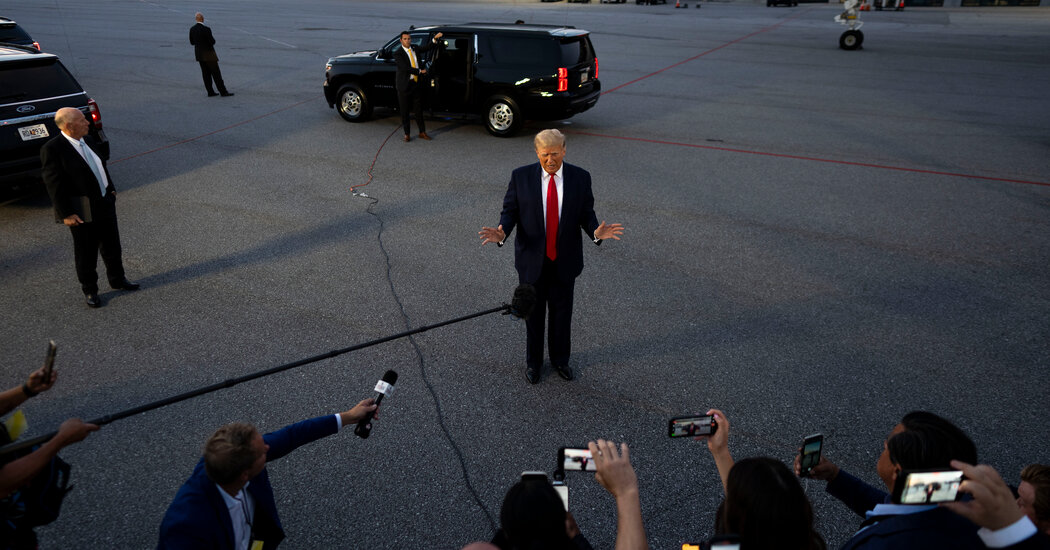What the ‘Uncommitted’ Vote Means for Biden in November
Source: The Associated Press
Note: Caucuses, held in Hawaii and Iowa, and states where President Biden was not on the ballot (New Hampshire) or was the only option (Mississippi) are not included.
So far this year, an average of one in 10 Democratic voters has voted for “uncommitted” in states where that has been an option on the presidential primary ballot. Where “uncommitted” hasn’t been on the ballot, around 12 percent have voted for a named candidate other than President Biden.
All together, the average Biden protest vote — the percent of the Democratic primary vote going to “uncommitted” or to minor candidates — stands at 13 percent.
Tonight’s primaries could offer an opportunity to assess Mr. Biden’s appeal in a key state, Arizona, where Hispanic voters make up about a quarter of voters overall and an even greater share in parts of Phoenix and Tucson.
Share of non-Biden vote in Democratic primaries
Source: The Associated Press
In Illinois, where “uncommitted” is not on the ballot, pro-Palestinian groups are pushing voters to write in “Gaza.” There will also be Democratic primaries in Ohio and Kansas. (The Democratic primary in Florida was canceled after the state party certified only Mr. Biden for the ballot.)
Tonight will also be one of the first opportunities to assess the protest vote against former President Donald J. Trump now that his last major challenger, Nikki Haley, has dropped out. (Much of the voting in last week’s primaries in Georgia and Washington happened before Ms. Haley’s announcement.)
The Democratic protest vote so far this year is slightly higher than the historical norm. In uncompetitive Democratic and Republican presidential primaries in 2004, 2012 and 2020, the typical protest vote was about 7 percent.
Those who have voted against Mr. Biden so far fall into three rough groups that highlight the challenge he faces as he looks toward the November general election.
Group 1: Young voters and Muslim American communities
Share of “uncommitted” vote in areas with more younger or older voters
Sources: The Associated Press; state and county websites; L2; Census Bureau
In Michigan, Minnesota, Washington and Massachusetts — four of the five states where “uncommitted” has done best so far — there was a clear and consistent trend. Areas with higher shares of younger voters were much more likely to vote against Mr. Biden in the primary. In Seattle, two of the areas with the highest share of “uncommitted” voters were Capitol Hill, a popular neighborhood among young professionals, and the University District, home to the University of Washington.
Mr. Biden’s relatively poor performance in these areas suggests a continuing weakness among younger voters. That is a trend that has also shown up in surveys, including New York Times/Siena College national and battleground state polls, which show Mr. Trump gaining ground among voters 18 to 29.
Precinct-level results also indicate that the protest vote is strong in Muslim American communities. This was most noticeable in Michigan, where, in majority-Arab areas, 79 percent of the vote went to “uncommitted,” most likely representing a protest against Mr. Biden’s Gaza policy.
Younger voters and Muslim Americans are a small share of the electorate, and it is unclear how their protest in the primary will affect the general.
In places like Michigan, however, where the margins tend to be razor-thin, their votes — or decision to stay home — could prove decisive.
Group 2: Democrats in name only
North Carolina, where “no preference” received 12.7 percent of the vote, does not follow the same trend. There, areas with a higher share of younger voters were not necessarily more likely to vote against Mr. Biden.
There is another, older phenomenon at play.
North Carolina, like many Southern states, is home to a large number of voters who long ago registered as Democrats but who now vote for Republicans in presidential elections — voters who are effectively Democrats in name only (DINOs). It is also a semi-closed primary state, meaning these conservative voters who are registered as Democrats can participate only in the Democratic primary. When stuck with a Democratic primary ballot, they may be more inclined to cast a protest vote than to support the incumbent.
Party registration patterns can help highlight where DINOs are concentrated.
Robeson County, where Mr. Biden performed worst in North Carolina in the primary, is a prime example. In Robeson, which is just outside Fayetteville and borders South Carolina, there are more than twice as many registered Democrats as registered Republicans. Yet in the 2020 general election, Mr. Trump won the county handily with about 59 percent of the vote. The disparity between party registration and presidential election results suggests Robeson has a substantial population of registered Democrats who voted for Mr. Trump in 2020.
This trend holds true across the state. The protest vote against Mr. Biden was highest in counties where the share of voters who are registered Democrats is much greater than the share of voters who voted Democratic in the last presidential election.
Where the Biden protest vote did best in North Carolina
Sources: The Associated Press; L2
Note: For each county, the ratio is calculated by dividing the share of registered Democrats by the share of the vote Mr. Biden received in the 2020 general election.
A similar pattern played out in Oklahoma, where Mr. Biden received just 73 percent of the vote, with the remaining 27 percent going to candidates like Dean Phillips and Marianne Williamson. (“Uncommitted” was not an option on the ballot.) Small, rural counties like Cimarron and Coal, where protest votes did best, are also places where Mr. Biden fared worse in 2020 than registration patterns would have suggested — in other words, places where the DINO contingent is strong.
Where the Biden protest vote did best in Oklahoma
Sources: The Associated Press; L2
Note: For each county, the ratio is calculated by dividing the share of registered Democrats by the share of the vote Mr. Biden received in the 2020 general election.
DINOs are not a new phenomenon. In the 2012 presidential primary, President Barack Obama won just 22 percent of the vote in Coal County.
In future elections, however, they may be less common. Many DINOs of 2012 have since become registered Republicans. For example, in 2012, 80 percent of voters in Coal County were registered Democrats. Now, only 43 percent are.
Unlike younger voters or Arab Americans, DINOs probably did not vote for Mr. Biden in 2020, nor are they likely to vote for him in November. Thus, their lack of support for him in the primaries has less significance for the general.
Group 3: Latino communities
In 2020, majority-Latino precincts in key states like Arizona, Florida and Texas swung to the right. And polls have consistently shown an erosion in support for Mr. Biden among nonwhite voters, including Latinos, over the last four years.
Primary results in Texas add more evidence of this shift: In the heavily Latino counties of the lower Rio Grande Valley, Mr. Biden averaged less than 65 percent of the vote in the Democratic primary earlier this month. In 2012, Mr. Obama, who was similarly running for re-election with only token opposition in the primary, won these counties with more than 85 percent of the primary vote.
In the Texas Democratic primary, Biden underperformed in majority-Latino counties along the Rio Grande Valley
Sources: The Associated Press; Census Bureau
The results in Hispanic communities contain elements of both the previous groups: The Hispanic voting population is relatively young, and as Latino voters have become less reliably Democratic, more of them have become DINOs.
In Texas, unlike in states where voters are limited by their party registration, voters can choose to vote in the party primary of their choice, suggesting Democratic primary voters there still actively identify with the party, even if they are casting a protest vote against Mr. Biden.
Sources and methodology
County- and township-level election results are from The Associated Press, as of 10 a.m. Eastern on March 19. Caucuses, held in Hawaii and Iowa, are not included in the analysis because of their different voting systems. New Hampshire and Mississippi are also not included. In New Hampshire, Mr. Biden was not on the ballot; in Mississippi, he was the only option on the ballot. Precinct-level results are from various state and county election night reporting websites. Demographic data is calculated from the Census Bureau’s American Community Survey. Voter registration statistics are from L2, a nonpartisan voter data vendor.
In the analysis, “uncommitted” refers to a named option on the Democratic primary ballot labeled as “uncommitted” or a similar option such as “no preference,” “noncommitted delegate,” or “none of these candidates.”
In the bar charts showing the share of the “uncommitted” vote in areas with more younger and older voters, younger areas refer to precincts or townships where the share of voters ages 18 to 34 falls within the top 25 percent in each state, and older areas refer to precincts or townships where the share of voters ages 65 and above falls within the top 25 percent in each state. The chart for Michigan includes precinct-level data from 27 counties that represent 70 percent of the total votes cast. In Washington State, precinct-level data was immediately available only for King County and does not include a small share of late-arriving mail ballots.


